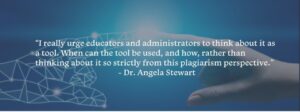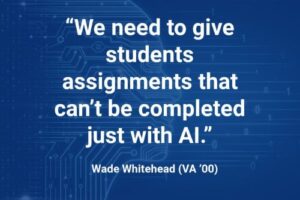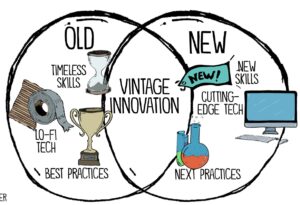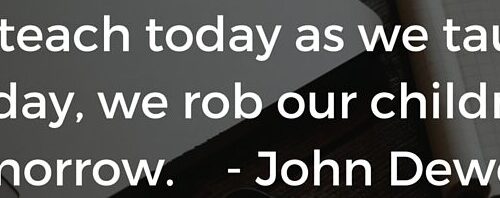Artificial Intelligence has landed on the educational landscape with a “boom” and it has rocked our world (or at least mine!).  Within the last two years, I have gone from thinking that using AI was unethical and there was absolutely no way I was going to use it, to using it frequently, to help me with lesson planning and assessment.
Within the last two years, I have gone from thinking that using AI was unethical and there was absolutely no way I was going to use it, to using it frequently, to help me with lesson planning and assessment.
This week’s debate on whether AI revolutionizes education was insightful and thought provoking. Like many of the debate topics we have tackled in this class, I find myself sitting on the fence with the impact of AI in education. Both teams made very strong points of why they believe AI is going to revolutionize education and why they don’t think it will.
Yes to AI!
Sheila and Teagan argued that AI is revolutionizing education, noting that like past technologies, it faced initial resistance but ultimately led to transformation. They highlighted how AI supports personalized learning, boosts engagement, and challenges students at their level. I was surprised to learn that AI-assisted learning can increase engagement by 55% and reduce learning time by 40%. They also pointed to improved inclusion through translation tools and reported gains in Canadian schools, including a 30% rise in achievement and 25% increase in participation. “we are not witnessing the demise of education as we know it, but the evolution of pedagogy”, reshaping how we think, create and connect.
But is AI, the silver bullet?
On the other side, Daegan and Jessalyn raised important concerns about AI in education. They highlighted issues such as data privacy, misinformation, and students’ inability to distinguish between real and false content. They also argued that AI reduces human interaction, diminishes the teacher’s role, and limits peer engagement. Unequal access to technology was noted as a potential source of social divide, and they cautioned that AI may contribute to academic misconduct and weaken students’ critical thinking skills.
Revolutionize is a strong word.
I think the issue I have with this debate is of the use of the word “revolutionize”. The word “revolutionize” means to completely change something so that it is much better. And at this moment, I am not sure if AI has made education better. Has it reshaped my thinking? Sure. Has it been a useful tool for creating content, lesson planning and generating ideas? Absolutely. Have I been able to incorporated it effectively and ethically in my classroom? No, not yet.
When I think about AI’s ability to “revolutionize” education, two points come to mind: What does effective implementation of AI look like in my classroom? And how does this new tool impact my role as an educator?
 The use of AI in classrooms can feel overwhelming. While many articles call for us to “make learning robot-proof” by changing how we teach and assess, that is easier said than done. Teachers are already stretched thin, and now we’re expected to navigate the complex world of AI and its seemingly endless capabilities, often with little support. AI is already in our schools, but there’s been minimal professional development or meaningful discussion on how to use it effectively. In the following article, it states that we need
The use of AI in classrooms can feel overwhelming. While many articles call for us to “make learning robot-proof” by changing how we teach and assess, that is easier said than done. Teachers are already stretched thin, and now we’re expected to navigate the complex world of AI and its seemingly endless capabilities, often with little support. AI is already in our schools, but there’s been minimal professional development or meaningful discussion on how to use it effectively. In the following article, it states that we need to address the “elephant in our classrooms.” Educators must adapt their teaching and assessment practices in ways that are both educationally sound and ethically responsible. If AI is here to stay, are school divisions doing enough to support teachers? Are they offering the PD we need to integrate AI into our classrooms with confidence and care?
Role of the Teacher and AI
A challenge for every educator when new technology lands in our lap is figuring out how to use it and and how our teaching needs to change with its implementation. For example, when I first learned about tech tools like Blooket, Kahoot, and Padlet, I had to consider how to meaningfully integrate them into my lessons. What was the purpose of having my class post on Padlet? Why were my students participating in a Kahoot? It wasn’t just about using the tool, it was about using it with purpose. And I believe that’s exactly what I need to figure out with AI.
One thing is for sure, AI will not replace me. In the article “Will Artificial Intelligence (AI) Take Over Online Teaching?” the author states that AI is not intended to replace human teachers, but rather to enhance their capabilities and support more effective learning environments. Furthermore, they argue that AI cannot replace human teachers because:
- Personalized Learning: AI can’t replace the vital role teacher’s play in nurturing student’s emotional intelligence.
- Complex Learning Tasks: AI lacks the capacity to navigate the complexities of human cognition.
- Social and Emotional Learning: AI can’t replicate the unique bond between teachers and students.
- Human Motivational Tactics: AI does not have the motivational tactics that teachers have, to keep students on task and engaged.
New Perspective
In the following article, John Spencer talks about two common dead ends when it comes to AI in education. The first is what he calls “The Golden Promise of Futurism”, the tendency to chase the newest tech just because it’s flashy, without thinking about long-term sustainability or the unintended consequences. The second is the “Lock It and Block It” approach, where schools try to ban or control technology so tightly that it becomes disconnected from students’ real lives. Both approaches miss the mark. Spencer suggests a third, more balanced path: the Human Approach. He asks a powerful question “What is it that we, as humans, can do that machines can’t?” This approach focuses on things like empathy, creativity, curiosity, and seeing the world through our own unique perspective. In a world increasingly shaped by AI, these are the qualities we need to help students develop and it’s where educators truly shine.
My Conclusion: Vintage Approach
As I try to determine where I stand with AI in education, I keep coming back to two words: balance and purpose. AI is here to stay, it’s not going anywhere, but it’s not going to replace what I do as an educator. What it will do is challenge me to rethink how I do things.
After witnessing many waves of new technology throughout my career, I have learned that it doesn’t have to be either/or. It is possible to create a learning environment that blends timeless skills, low-tech practices with new and innovative technology. This approach is known as the Vintage Innovation Approach. As Spencer states, we don’t need to block every new tool out of fear, nor do we need to blindly  chase every shiny new tool. Instead, we find a thoughtful middle ground to combine timeless strategies with emerging technologies. We combine best practices with next practices. And that is something I can get on board with!
chase every shiny new tool. Instead, we find a thoughtful middle ground to combine timeless strategies with emerging technologies. We combine best practices with next practices. And that is something I can get on board with!

5 Comments
Jenna Reimer-Jones
Hi Leanne,
Your comment about professional development and supporting teachers with technology integration is such a great point. While I am aware that there are more ways I could utilized technology in my work, I find it somewhat overwhelming knowing where to start. Learning how to use new technology can at times be a demanding and tiring process. However, the more we understand, the better we can teach children to use technology and AI responsibly. I agree with you that technology doesn’t have to be either/or but a balanced purposeful approach.
Jenna
Kritika Sehgal
Hi Leanne,
Reading your post really reminded me of my own experience exploring AI tools. I also didn’t realize how much I was already using it in various forms. Like you, I’m still figuring out what meaningful use looks like in the classroom, rather than just using technology for the sake of it.
Your mention of Kahoot and Padlet brought back memories of how excited my students were when we tried those for the first time. Now with AI, I feel the same mix of curiosity and caution. As a former teacher in India, I often had to be creative with limited technology, so this whole shift feels big but also full of opportunity.
I especially liked your point about “Vintage Approach.” It’s such a powerful idea, blending what works from the past with today’s tools. I’m learning that not every lesson needs to include AI, but we can still embrace it where it makes sense.
One suggestion I’d make is maybe expanding a little more on how you think PD (professional development) could support teachers, even just one example would help others visualize that better.
Thanks again for sharing your thoughts.
Kritika
Teagan Schiltz
Hey Leanne!
I always enjoy reading your posts – this week is no different! I love that you bring your own experiences into each week’s topic and appreciate the reflective nature of your writing. You consider some important questions in relation to AI in education – I agree that AI integration feels overwhelming and, due to its newness and ever-evolving nature, we have a lot to learn to ensure we are using it intentionally, as with any new tech!
I, too, found comfort in John Spencer’s work and promotion of a human-centered approach to education to combat fears of AI taking over or replacing the teacher. I also spoke to his concept of ‘vintage innovation’ in my blog post and found it helped me understand how I can intentionally incorporate AI with educational practices that promote student-centered learning opportunities. I LOVE how you conclude: “We combine best practices with next practices.” I couldn’t agree more!
Thanks!
Teagan Bryden
Sheila Farnell-Luff
Thank you Leanne for sharing your thoughtful reflection on AI.
I agree with you that there needs to be a thoughtful balance between the use of technology and pedagogy. While technology allows for new experiences and skills, it cannot replace practical application skills. Blending both approaches allows for a more balanced approach and broadens the skill set our students learn.
I am concerned about how far behind policy is compared to our implementation of ai in society. I feel this leaves the door open for political influence from companies with regards to curriculum (which is already an issue), inflationary prices after its importance is demonstrated, and a lack of critical consideration regarding implementation procedures. Without this guidance, I feel PD would almost be a waste. We haven’t decided the direction we need to take with this technology, so how can we critically train our teachers with its implementation?
Our legislative branch is notoriously behind regarding technology legislation. I feel that AI evolves so rapidly that our governments will be unable to keep pace. It is an interesting obstacle a lot of governments will have to address and resolve soon if they want to protect their digitally bound citizens.
Sarada Dhakal
Hi Leanne,
Of Course, AI should be a part of classroom education with a focus on balance and purpose.
As an English teacher in Nepal, I have had a similar journey. At first, I was unsure about using AI, but with encouragement from a colleague, I started exploring it. Later, I started using AI tools for grammar checks, writing prompts, and feedback. This really helped my students, especially those who struggle with sentence structure and vocabulary. These tools supported their learning, but students really relied on teachers. Teachers should not viewed as a ultimate source of knowledge but as a guide to students in construction of knowledge. So, ‘Vintage’ approach to education is really the need of the day. In a setting like mine, where access to technology is still growing, blending traditional methods with modern tools makes a lot of sense. Your post reminded me that good teaching always finds that thoughtful balance.
Sarada